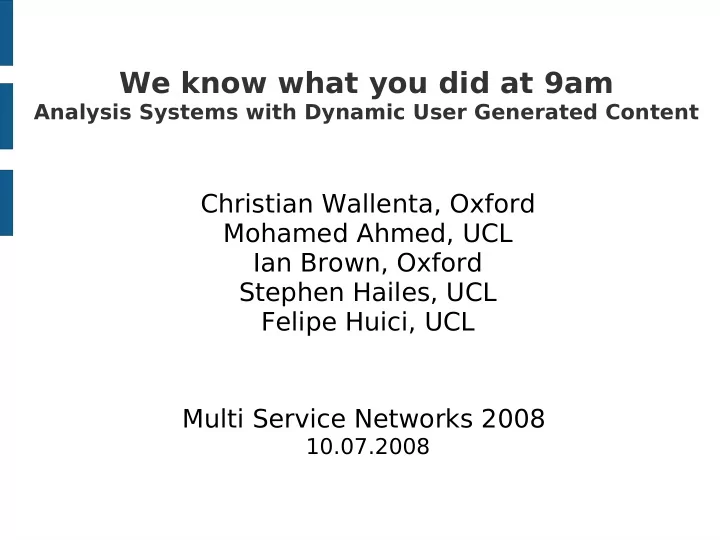

We know what you did at 9am Analysis Systems with Dynamic User Generated Content Christian Wallenta, Oxford Mohamed Ahmed, UCL Ian Brown, Oxford Stephen Hailes, UCL Felipe Huici, UCL Multi Service Networks 2008 10.07.2008
Motivation ● Understand how data enters these systems ● Understand how data evolves over time --> Derive models that explain when and from where data comes into these systems --> Apply these models to a wider range of applications to optimise their performance 10.07.2008 MSN 2008 2
Quick Overview 10.07.2008 MSN 2008 3
Datasets ● digg.com – 1.5 million posts including submission time, author, number of votes between May and November 2007 – 1.6 millions votes for 87,000 posts between Nov, 21 st and Dec, 1 st 2007 – 240,000 user profiles ● reddit.com – 183,000 posts (Nov 07 to Feb 08) – 13,300 posts + votes (Nov,23 rd to Nov, 30 th ) 10.07.2008 MSN 2008 4
Content Generation Trend 50,000 posts in May to 65,000 in November 2007 10.07.2008 MSN 2008 5
Content Generation Volume per Week reddit.com 10.07.2008 MSN 2008 6
Content Generation Volume per Week digg.com 10.07.2008 MSN 2008 7
Content Generation User Contribution 10.07.2008 MSN 2008 8
Content Generation User Contribution 10.07.2008 MSN 2008 9
Popularity Analysis Votes Distribution ● What % of the votes goes to what % of the post? 10.07.2008 MSN 2008 10
Popularity Analysis Votes Distribution ● What % of the votes goes to what % of the post? ● If votes~popularity then this distribution is always interesting for caching 10.07.2008 MSN 2008 11
Popularity Analysis Popularity Evolution ● Now we know static behaviour, but... ● How fast does this happen? ● How long does content stay popular? ● Monitor posts from submission time until they become inactive 10.07.2008 MSN 2008 12
Popularity Analysis Popularity Evolution digg.com 10.07.2008 MSN 2008 13
Popularity Analysis Post Lifetime 10.07.2008 MSN 2008 14
Analysis Summary ● Lots of content, periodic patterns ● Few users create most of the content ● Most votes go to a few posts ● Content becomes popular fast, and has a short lifetime in contrast to e.g. YouTube 10.07.2008 MSN 2008 15
Data Generation Model Motivation ● Understanding where data comes from and when ? ● Develop a simple , generalisable model that describes: – the volume of content posted at any given sample interval – the relative contribution of each of the 24 possible time zones – the expected user behaviour throughout a 24h period 10.07.2008 MSN 2008 16
Data Generation Model Identifying the dominant frequencies Problem: Unprocessed time series is noisy 10.07.2008 MSN 2008 17
Data Generation Model Identifying the dominant frequencies Method: Apply Fourier Transformation to identify the dominant frequencies. 10.07.2008 MSN 2008 18
Data Generation Model Identifying the dominant frequencies 10.07.2008 MSN 2008 19
Data Generation Model Identifying the dominant frequencies 10.07.2008 MSN 2008 20
Data Generation Model Step 2: time zone distribution ● Problem: – Fourier gives us dominant frequencies, but no information from where the content was submitted. ● Method: – Incorporate user location information into the Fourier model. ● Assumptions: – Majority of users state correct location – Users that do not reveal location are proportionally distributed in their geographical location 10.07.2008 MSN 2008 21
Data Generation Model Step 2: time zone distribution ● Problem: Some countries have more than 1 time zone ● Assumption: User distribution is the same as popularity distribution within the zones 10.07.2008 MSN 2008 22
Data Generation Model Step 2: time zone distribution 10.07.2008 MSN 2008 23
Data Generation Model Step 3: expected user behaviour ● Idea: – Content volume per time interval is the sum of contribution of all time zones ● Assumption: – Users in different zones follow roughly the same usage pattern x ? = 10.07.2008 MSN 2008 24
Data Generation Model Step 3: expected user behaviour 10.07.2008 MSN 2008 25
Data Generation Model Step 3: expected user behaviour 10.07.2008 MSN 2008 26
Data Generation Model Step 3: expected user behaviour 10.07.2008 MSN 2008 27
Data Generation Model Model applied to reddit.com initial fit: 10.07.2008 MSN 2008 28
Data Generation Model Model applied to reddit.com adapted weights: 10.07.2008 MSN 2008 29
Model Summary ● Periodic pattern can be modelled with few dominant frequencies ● Time zone analysis reveals where content comes from ● Decomposed model describes user behaviour within a single time zone 10.07.2008 MSN 2008 30
Design Implications Applying Geo-Temporal Information ● Energy-efficient load balancing – (Chen et al, NSDI 2008) ● Similar patterns exhibited in – Facebook (Golders et al, CT 2007) – MSN (Chen et al, NSDI 2008) – Gaming (Chambers et al, IMC 2005) ● Peer-to-Peer Churn / Content Distribution – neighbour selection / replication 10.07.2008 MSN 2008 31
Example 10.07.2008 MSN 2008 32
Future Work ● Comparing different node selection strategies when replicating data in distributed systems ● Can taking into account time zone information increase performance? ● Test other datasets ● How can time zone behaviour be learned in a distributed way? 10.07.2008 MSN 2008 33
The End Thank you 10.07.2008 MSN 2008 34
Content Generation Link Analysis ● Aim: – Understand what “content” is submitted – What “content” becomes popular – Does the user filtering achieve anything? 10.07.2008 MSN 2008 35
Content Generation Link Analysis 10.07.2008 MSN 2008 36
Content Generation Link Analysis 10.07.2008 MSN 2008 37
Popularity Analysis Popularity Evolution reddit.com 10.07.2008 MSN 2008 38
Data Generation Model Step 3: expected user behaviour ? = x 10.07.2008 MSN 2008 39
Data Generation Model Step 3: expected user behaviour ● Solve linear equations 10.07.2008 MSN 2008 40
Data Generation Model Step 3: expected user behaviour x ? = 10.07.2008 MSN 2008 41
Design Implications Popularity Prediction ● Content popularity follows 80-20 rule: Caching can increase performance ● Problems/Challenges: – constantly new content comes into the system – content becomes popular rapidly – content has short lifetime Cacheable content needs to be identified early 10.07.2008 MSN 2008 42
Recommend
More recommend